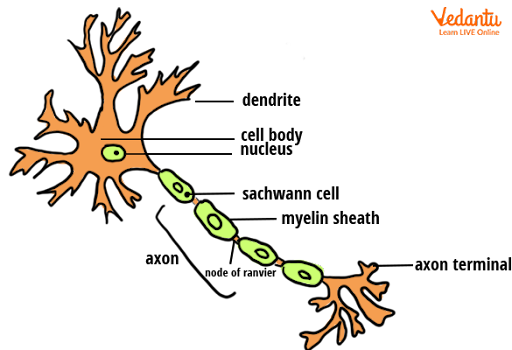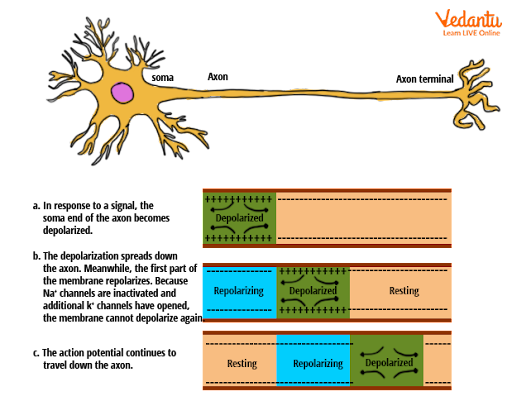




What is a Nerve Impulse?
A nerve impulse is an action potential that travels from the cell body to the synapses along the axon. The repetition of action potentials along an axon is known as propagation. A stimulus is a change in the environment (internal or external) that triggers a response when detected by a receptor. Ions cannot pass through the membrane directly due to the lipid bilayer. They can only cross it through a few narrow canals.
The K+ channels are open in the resting state of the nerve, while the Na+ channels are closed. There is a total negative charge within the cell. K+ can easily (diffusely) leave the cell, whereas Na+ cannot (because the channels are closed). Inside the cell, negatively charged ions are unable to flow through the membrane. The Na+/K+ ATPase pump travels three times every second. The Na+/K+ ATPase pump exchanges three Na+ ions for two K+ ions. The outflow of K+ leaves the cell with a net negative charge.
Cells of Nervous System and Nerve Impulse Conduction
The two major cells of the nervous system in the body are neurons and neuroglia.
Neurons: The nerve cell designated as the "functional unit" is the neuron. The nervous system's impulses are transmitted through these cells. The cell body, axon, and dendrites make up a neuron.
Cell Body: The nucleus and cytoplasm are found in the cell body.
Axon: The axon is a single thin projection extending from the cell body. Some are encased in a myelin sheath, which protects the axon and speeds up impulse transmission. The component of the nervous system is made up of axons that aren't wrapped with myelin sheath and appear grey. The component of the nervous system consists of axons that are wrapped in myelin sheath and appear white.
Dendrites: Dendrites are little branches that branch out from the cell body like tiny trees. It receives and transmits impulses to the cell body.

Image: Structure of a neuron
Neuroglia: Neuroglia is a unique sort of nervous system "connective tissue." The neurons are supported by this mechanism. They use "phagocytosis" to defend the nervous system. Astrocytes, Microglia, and Oligodendrocytes are the three different types of neuroglia cells.
A nerve impulse is an electrical current that travels along the cell membrane of a neuron. Electrical current is the movement of electrically charged particles in a nerve, called ions. To create an electrical current, you must first create a charge difference: more (+) in one area and more (-) in another.
Three Types of Neurons and Functions
Neurons are of three types- sensory neurons, motor neurons, and interneurons. Sensory neurons, which are present in the peripheral nervous system, transport impulses from stimuli to the CNS (PNS). Motor neurons, which are present in the PNS, convey signals from the CNS to activate muscles in the body. Interneurons, which are present in the brain and spinal cord, connect sensory and motor neurons (CNS).
Properties of Nerve Fibres
The axon of a nerve cell (neuron) is what makes up a nerve fibre. The nerve cell's body is located either in the central nervous system or in the peripheral nervous system's ganglia.
Axon (nerve fibre) comes from the axon hillock, a mound on the soma. An axon has a cylindrical shape. The membrane of an axon is called the axolemma. Dendrite allows the process of a membrane's reaction. Synaptic Knob spreads via Soma and goes down the axon.
Properties:
Excitability/Irritability: Nerve fibre membranes are excitable and have the ability to respond to electrical impulses.
Stimulus
Conductivity
All or none law: According to the all or none law, if a stimulus does not reach a threshold and cause all of the Na⁺ gates to open, no action potential is produced. There is no going back once the threshold is exceeded, and the stimulus must be delivered.
Nerve Impulse Conduction
The distribution of active and electrical potentials along the conductors causes nerve impulse conduction. A synapse is a structure that allows impulses to be transmitted internally across cells. Neurotransmitters are chemicals that form in neurons and are transmitted from one neuron to another as chemical synapses.
Steps for Nerve Impulse Conduction:
The diffusion of sodium and potassium down the concentration gradients gives nerve fibres resting potential.
Neurons are stimulated, resulting in local potentials that may add up to approach a threshold.
In a limited section of the membrane, sodium channels are open. Ions of sodium diffuse inward, depolarizing the membrane.
The membrane's potassium channel is open. Ions of potassium diffuse outward, depolarizing the membrane.
An electric current is generated by the resting action potential, which activates neighbouring membrane segments.
As a result, a series of action potentials occur consecutively down the length of the axon.

Image: Nerve impulse conduction
Transmission of Nerve Impulse
The transmission of a nerve impulse from one terminal of a neuron to the other is caused by electrical fluctuations in the cell's membrane. Until a stimulus arrives, the neuron will be at resting potential, prompting local Na+ ions to diffuse inside the cell and depolarize the membrane.
The potential difference on the membrane of a neuron conducting an impulse is known as the action potential. When the threshold is reached, Na+ channels open and Na+ rushes in, causing the neuron to depolarize. After that, Na+ channels close, voltage-gated K+ channels open, and K+ diffuses out. The refractory period is the time between openings when the channels are closed. The Na+/K+ pump returns resting potential.
Conclusion
This article has given all the useful details about the cells of the nervous system and nerve impulse conduction with respect to the NEET syllabus. The questions that are provided at the end of this article are useful and important from the exam’s point of view. These also help in clearing up the doubts about this topic and help in qualifying for the exam.
FAQs on Cell of Nervous System and Nerve Impulse Conduction for NEET
1. What factors influence the speed of nerve impulse conduction?
The speed at which a nerve impulse is transmitted is determined by whether the nerve is myelinated or unmyelinated, the diameter of the axon, and the temperature. Myelination affects the speed by dramatically increasing the rate at which impulses are transmitted. Axon diameter also affects the conductance speed. The faster the conductance, the higher the temperature.
The action potential is determined by ion diffusion, which increases with temperature as the kinetic energy of the ions increases. Respiration provides the energy for active transport, which is controlled by enzymes that operate more quickly at higher temperatures.
2. What causes the release of neurotransmitters?
The primary type of presynaptic cell is a neuron. Neurotransmitters are released by neurons, effectively converting an electrical signal or action potential into a chemical signal that can interact with the postsynaptic cell across the synaptic cleft. Voltage-gated channels open and calcium enters the cell when an action potential reaches the synaptic terminal. When calcium is present, vesicles merge with the presynaptic membrane and release neurotransmitters into the synaptic cleft.
During an axon potential, calcium enters the axon terminal. These calcium ions activate other ion channels because the charge carried by calcium is positive and it increases the action potential of vesicles that carry neurotransmitters.
























